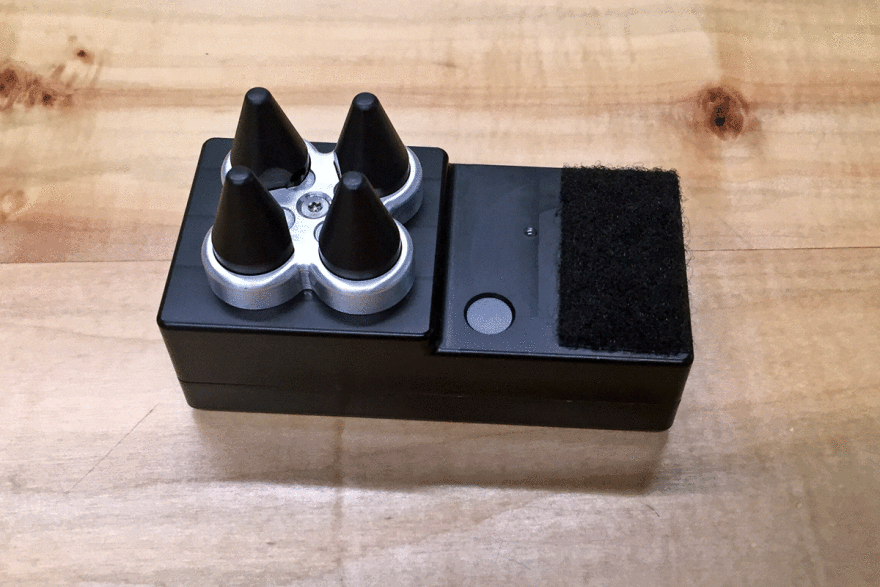Colorado State University researchers are working on finding new ways to measure air quality. To help pilot a new wearable air quality monitor, they’ve turned to people like Katherine Steger. The thing is, Steger is a fifth-grader.
“Eventually the hissing noise it would make when it would suck in the air became kind of soothing to me, helped me go to sleep at night, it really sort of helped me,” she told a CSU asthma researcher in a focus group at the end of the study. “I didn’t notice it was there.”
Steger and her classmates at Fort Collins’ Rivendell Elementary helped Dr. John Volckens and his team test the what’s called the Automated Microenvironmental Air Sampler.
The A-MAS is a small black box, roughly the size of an iPhone but twice as thick. On the front are four black cones that suck in air every time the user enters a new environment. Inside is a GPS and an accelerometer, similar to the hardware in most phones that tracks movement.
Steger’s classmates in the focus group discussed flukes with the device - loud noises, faulty batteries, uncomfortable harnesses. Many suggested a wristband, similar to a FitBit. One child recommended that the device not be wearable at all, but more like a robot that followed you around all day, like BB-8 from Star Wars: The Force Awakens.
Volckens was awarded a $181,241 grant from the National Institutes of Health to develop the device. Children were his first choice, since they’re most susceptible to air pollution and its adverse health effects.
Wearing the A-MAS for a couple of days at a time, the students then traded it out for a backpack filled with clunkier air quality monitoring equipment. Volckens said the more cumbersome backpacks contained the “gold standard” in air quality measurement -- the A-MAS’ competition.

On the last day of the study, Volcken’s team gathered Steger and her classmates for a science lesson. Casey Quinn, a Ph.D. student who helped design the A-MAS, has been in for regular visits, teaching them not only how the device works, but sharing their goals for the study, some of their data and demonstrating just how air pollution is measured inside the A-MAS.
In short, he’s teaching them how to be scientists.
“We really didn’t want to walk in and use the kids as test subjects,” he said. “We really wanted to make this a two-way street for them, to engage them and see what researchers are doing at CSU.” Sheryl Magzamen, a CSU researcher who also spent time with the children in the classroom, said they were hungry for more scientific study.
“We came in wanting to talk about air pollution, and they really expanded our thinking,” she said. “They wanted to talk about gamma rays and black holes.”
One child who participated in the study, Owen Terpstra, hoped the A-MAS would one day help asthma sufferers like himself.
“I thought it was really cool that CSU - a certain group of people - were working on an asthma detector,” he said.
To be clear, the A-MAS is not an asthma detector, but it’s not far off. Volckens’ team certainly had people like Terpstra in mind.

“We can go and tell one set of parents ‘your child’s asthma is worse at your home and you need to intervene and make the air inside your home cleaner.’ Or we might find that some kids on their commute to school have really high air pollution exposures, and those parents might want to find a different route to get their child to school,” Volckens said. “For some children we might find that all of the environments are equally as polluted and unfortunately there’s not a lot they can to besides maybe talk to their congressman.”
If the A-MAS does prompt a parent to call their congressman about air quality, Volckens wants that lawmaker to have more detailed information too.
“The U.S. [Environmental Protection Agency] is charged with regulating outdoor air pollution. So, they monitor it all across the country, typically one monitor per county,” he said. “Now if I were to tell you that there was one monitor in Greeley, or one monitor in Fort Collins that was trying to assess your daily intake of air pollution, you’d probably think ‘well, where is that monitor, and is it doing a good job of protecting me and evaluating what I’m inhaling?’”
With the the A-MAS, the EPA could one day have several thousand roving monitors per county, painting a far more detailed picture of air quality. That level of detail could enable lawmakers to better address problem areas.
If Volckens can prove the device works, the next step is to do a comprehensive health study using the device in the greater Fresno, California area -- one of the nation’s most polluted cities.
“So we’ll enroll up to 200 kids, they’ll wear the monitor for a couple of days over the course of a summer. That will allow us to then understand, for these kids with asthma, where is your air pollution exposure worse?” he said. “Is it at home? Is it at school? Is it on the roadways, is it on athletic fields that you play on?”






